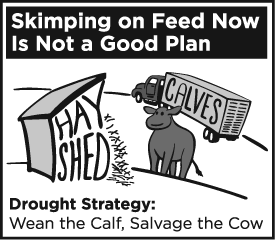
Kris Ringwall
Beef Talk
Take steps to minimize the effects of this year’s drought on next year’s production.
Mother Nature has changed everything — again.
The upper Midwest’s dry to drought conditions have changed stocking rates, challenged pasture rotation schedules, hastened the end-grazing date, and limited cow and calf condition scores. Producers need to work through the present and take steps to minimize the effects of this year’s drought on next year’s production.
By weaning and pregnancy-checking early, thin, pregnant cows have a chance to improve condition once the calves are weaned. Move out any open or late-bred cows. Wean the calf early, and pay attention to the markets for a good time for selling the calf.

Skimping on feed this year will affect pregnancy rates next year.
An important point still remains: Much of the country is not short on feed, and timely marketing in response to the broader market trends is important. Finding a way to hold the calves to allow for a good market strategy is good common sense. However, keeping the calves gaining in a drylot takes some homework. For now, focus on the cow and wisely stretch the feed on the good keeper cows.
The cows will not come off in normal condition, and do not put off what is inevitable — thin, pregnant cows. So, start looking at feed resources, and once the calves are weaned — earlier rather than later this fall — the dry cow needs to put back on some condition.
The nutritional requirements of a cow whose calf was weaned are lower when milk production ceases. So the thought for the day is: If one buys feed, why not plan on feeding when the cow can better use the feed?
Waiting to add condition to a thin cow is difficult. The cow advances daily in fetal growth. The third trimester of pregnancy will be here soon and the cow will need to be eating to support the accelerated growth of the calf. Plus, the potential harshness of the upcoming winter will demand more thermal output to survive. Her daily feed intake will be needed to keep the unborn calf growing and stoking her internal furnace for heat.
To make matters worse, as soon as she calves next spring, all hands on deck because milk production kicks in as the cow turns into a perpetual milking machine. Feed in, milk out is not a time to be in poor condition. So when hay is expensive, feed it when it will do the most good — this coming fall. Do not rule out additional pasture supplements, or drylot the cows and add grain to the ration this fall.
Again, the point is: Thin cows gain weight in the fall with less feed. The cow is pregnant, but the fetus is not quite so demanding. In the fall, the cow does not have to set aside some of what she eats to simply keep warm. She feels good, not like in late pregnancy, when she has to carry well in excess of 100 to 200 pounds of extra weight balanced on legs and a pelvis meant to come apart on short notice.
The bottom line: Be nice to the cow, and let her gain a little weight and put some flesh on this fall. Traditional timing and the business of upcoming fall work can cause one to miss this point. Skimping, skimping and skimping some more, and hoping the cows will survive until grass next spring is poor planning.
Thin cows always have that same look while walking single file, looking for feed where none is available, cautious with slight anxiety. Early-weaned, those thin cows have a chance to gain some easy weight.
Contrary to the tendency to let the cows rough it a little more in the nice weather to save feed for winter is not a good idea. While some think every week of saving feed is money in the pocket, that is not exactly true once a producer has made the needed cuts in inventory.
In summary, cows calving in March and April enter the third trimester in December and January, respectively. One can feed to the nutritional requirements of the beef cow; however, the many extenuating circumstances in late pregnancy and winter simply may not allow the replenishing of condition and muscle lost during a very dry summer.
This process starts a vicious cycle, where if the cows are calved too thin, the calves will be deprived of adequate colostrum, calves get sick and the cows do not rebreed on time to maintain a 365-day calving interval.
If this cycle repeats itself next year, the culling rate goes up and the overall health of the cow, and particularly the calf, is placed in jeopardy. So do not skimp in hopes of saving a few dollars. Reduce the cow numbers to meet the current estimated feed inventory.
This all seems to be rather complicated, but Mother Nature is tough, and running a business with Mother Nature as the primary partner is not easy. Passive planning and response is not the answer.
Decide today to visit your local Extension agent or nutritionist. Invest in feed cautiously, and target feed for the best cow response. Aggressively deal with inventory numbers, plan for next spring now and remember that when the weather is nice and the cows are thin, feed them.
May you find all your ear tags.
Editor’s Note: Kris Ringwall is a beef specialist with NDSU Extension Service. For more information, contact your local Extension Service agent or Ringwall at the Dickinson Research Extension Center, 1041 State Ave., Dickinson, ND 58601; 701-456-1103; or kris.ringwall@ndsu.edu.







